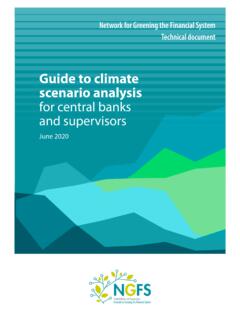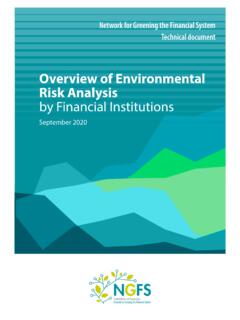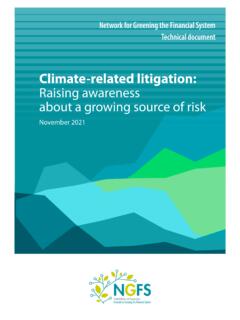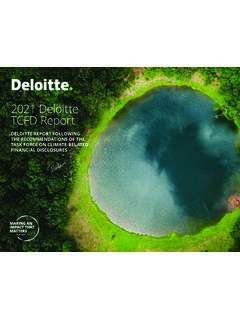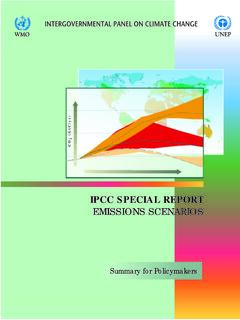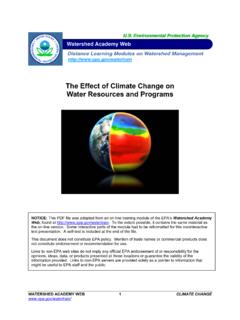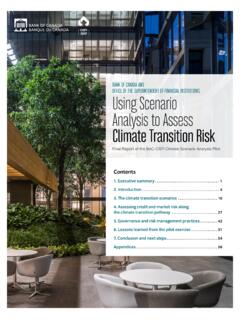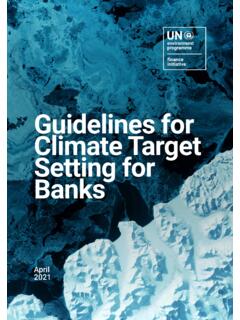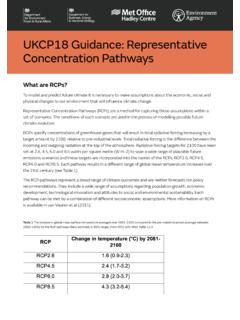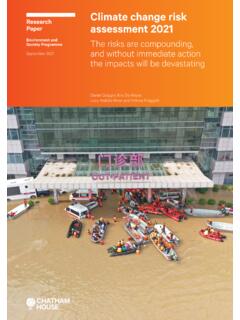Transcription of NGFS Climate Scenarios for central banks and supervisors
1 Network for Greening the Financial System NGFS Climate Scenarios for central banks and supervisors June 2021. Joint foreword It is our very great pleasure to present the second iteration of the NGFS' Climate Scenarios . They represent a true milestone in the race to better understand the risks from Climate change. The world is at a critical juncture where Climate pathways could move in materially different directions: from a successful transition to net-zero emissions by 2050; to a hot house world with global warming of 3 C or more by 2100. In the face of such uncertainty, Climate scenario analysis is a vital tool that helps us to prepare for a range of future pathways. And it does this by focussing minds on a variety of different outcomes, challenging users to consider what risks and opportunities might arise and crucially, what action might be required today in light of these potential challenges tomorrow.
2 A major obstacle to undertaking this analysis has been the availability of detailed Scenarios that analyse both the physical and transition risks from Climate change and their economic impacts. The challenges and costs of creating such Scenarios are beyond most individual firms or institutions, so it is against this background that the NGFS has developed a common Frank Elderson Sarah Breeden set of Scenarios . These Scenarios are designed to act as a foundation for analysis across many institutions, creating much Chair of the NGFS Chair of the workstream needed consistency and comparability of results. Indeed, a growing number of central banks , supervisors and private on Macrofinancial firms are already using NGFS Scenarios as a basis to better understand risks to financial systems, economies and their own businesses and balance sheets. We are proud of how far these Scenarios have come in a very short time.
3 It was just one year ago that the NGFS released its first iteration of NGFS Scenarios , a milestone in itself. The first iteration provided a foundation for Climate scenario exercises by offering a consistent set of pathways for global changes in policy, the energy system, and the Climate . Whilst an ambitious first step, these Scenarios represented a foundation for future work. This second iteration of the Scenarios takes a huge step forward. Not only does it include a mapping to impacts at a country level, but it includes nearly 1,000 economic, financial, transition and physical variables across six different Scenarios . These have been created through a suite of models, supported by a consortium of world leading Climate scientists and modelling groups. The variables are calibrated to the latest available data and will be kept up to date in future iterations to ensure their continued relevance. And all variables are made available for free on the NGFS website so that anyone can take advantage of the wealth of information they provide.
4 Huge strides have been made, but the opportunity to deepen Scenarios further remains large. For this reason, the NGFS will continue to invest in developing these Scenarios , and to welcome views from others on where development can be most valuably focussed. In doing this, we remain cognisant that the modelling of future pathways that encompass changes in policy and Climate are subject to significant uncertainties and valuable debate. To help navigate this uncertainty the NGFS Scenarios : provide six Scenarios with variable assumptions on future changes in policy and technology; utilise multiple models to provide a range of results and hedge against model bias; and are transparent on the underlying models and methodologies used. We are grateful to all of those that have contributed to these Scenarios and look forward to seeing them applied in practice. After all, as we improve our understanding of how the future can play out, we will be better equipped to take the actions that are needed today to reduce the risks of tomorrow.
5 NGFS Scenarios 2. Acknowledgements The Network for Greening the Financial System (NGFS) is a group of 91 central banks and supervisors and 14 observers committed to sharing best practices, contributing to the development of Climate and environment related risk management in the financial sector and mobilising mainstream finance to support the transition toward a sustainable economy. The NGFS Workstream on Macrofinancial has been working on updating the June 2020 NGFS Scenarios in partnership with an academic consortium from the Potsdam Institute for Climate Impact Research (PIK), International Institute for Applied Systems Analysis (IIASA), University of Maryland (UMD), Climate Analytics (CA), the Swiss Federal Institute of Technology in Zurich (ETHZ) and the National Institute of Economic and Social Research (NIESR). This work was made possible by grants from Bloomberg Philanthropies and ClimateWorks Foundation.
6 Special thanks is given to lead coordinating authors: Ryan Barrett (Bank of England), Antoine Boirard (NGFS Secretariat/Banque de France), Theresa L ber (Bank of England), Cl ment Payerols (NGFS Secretariat/Banque de France) and Edo Schets (Bank of England). Thanks is also given to contributing authors: Thomas Allen (Banque de France), Cathy Ansell (World Bank), Thessa Beck (CA), Christoph Bertram (PIK), Gilbert Cette (Banque de France), St phane Dees (Banque de France), Jae Edmonds (JGCRI/UMD), J r me Hilaire (PIK), Dawn Holland (NIESR), Ian Hurst (NIESR), Elmar Kriegler (PIK), Iana Liadze (NIESR), Olivier Mahul (World Bank), Miguel Molico (Bank of Canada), Laura Parisi (European central Bank), Franziska Piontek (PIK), Carl Friedrich Schleussner (CA) and Bas van Ruijven (IIASA). NGFS Scenarios 3. Overview Contents Transition Overview of the Scenarios 5. Scenarios in detail: Transition risks 13.
7 Physical Physical risks 25. Economic impacts 34. Development pipeline 42. Economic Development Annex / References NGFS Scenarios 4. Overview Overview of the Scenarios Overview Key messages Scenarios differ markedly in their physical and transition impacts, with significant uncertainty in the size of the estimates and variation across regions. The NGFS Scenarios have been developed to provide a common starting point for analysing Climate risks to the economy and financial system. While developed primarily for use by central banks and supervisors they may also be useful to the broader private sector, government and academia. In this second iteration, the NGFS Scenarios have been brought up to date, including by incorporating countries' commitments to reach net zero emissions, and have been enriched with an expanded set of macroeconomic variables, country level granularity, and an online portal through which users can explore the physical risks from Climate change.
8 Reaching net zero CO2 emissions by 2050 on a global basis will require an ambitious transition across all sectors of the economy. The NGFS Scenarios highlight a few important themes including rapid decarbonisation of electricity, increasing electrification, more efficient uses of resources, and a spectrum of new technologies to tackle remaining hard to abate emissions. The impacts on the economy will be modest, and even positive depending on how smoothly the transition occurs. While stronger policy incentives will be needed to spur on the transition, new economic modelling in this release suggests that higher private and public investment in new technologies and sectors would offset impacts on both demand and supply. However, it is prudent to assess a wide range of outcomes across different sectors and regions given the potential uncertainties. The NGFS Scenarios also highlight the increased macro financial risks that could crystallize in Scenarios with divergent policies or delay followed by stronger action, and from physical risks.
9 NGFS Scenarios 6. Overview Objectives and framework The NGFS Scenarios explore the impacts of Climate change and Climate policy with the aim of providing a common reference framework. The NGFS Scenarios explore a set of six Scenarios which are consistent with the NGFS framework (see figure) NGFS Scenarios Framework High published in the First NGFS Comprehensive Report covering the following dimensions: Disorderly Too little, too late Orderly Scenarios assume Climate policies are introduced early and become gradually more stringent. Divergent Both physical and transition risks are relatively subdued. Net Zero ( C) Delayed transition Disorderly Scenarios explore higher transition risk due to policies being delayed or divergent across . Transition risks countries and sectors. For example, carbon prices would have to increase abruptly after a period of delay. Net Zero Hot house world Scenarios assume that some Climate policies are implemented in some jurisdictions, but 2050.
10 Globally efforts are insufficient to halt significant global warming. The Scenarios result in severe physical ( C) Below risk including irreversible impacts like sea level rise. 2 C. NDCs Current policies These six Scenarios were chosen to show a range of lower and higher risk outcomes. The Scenarios have been further refined since the first iteration that was published in June 2020 to leverage the latest versions Low Orderly Hot house world of models, reflect the shifts in Climate policy since 2018, and reflect the near term IMF growth projection Low Physical risks High from COVID 19. Positioning of Scenarios is approximate, based on an assessment of physical and transition risks out to 2100. NGFS Scenarios 7. Overview Scenario narratives Each NGFS scenario explores a different set of assumptions for how Climate policy, emissions, and temperatures evolve. Net Zero 2050 limits global warming to C through CO2 emissions by scenario Carbon price development stringent Climate policies and innovation, reaching Gt CO2 / year USD (2010) t/CO2.
